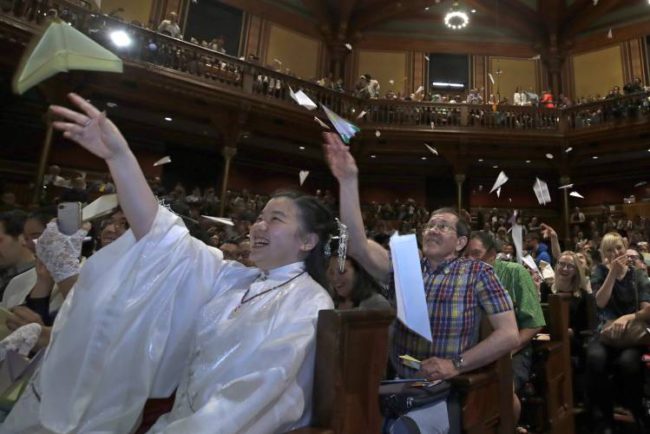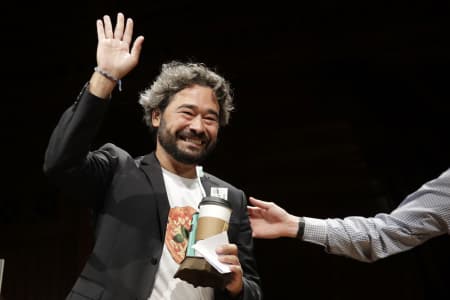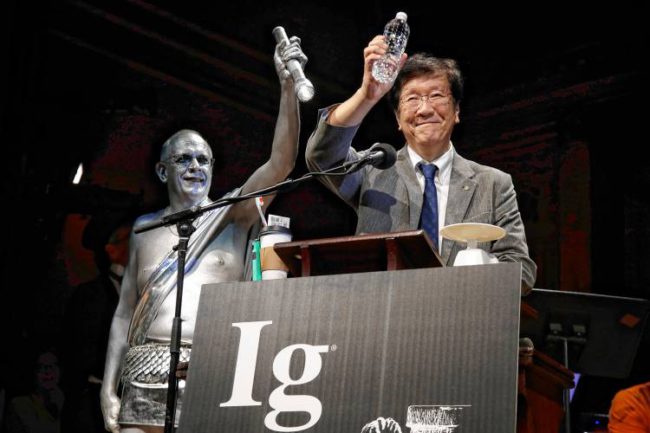
The 29th First Annual IgNobel Prize ceremony happened last night at the Sanders Theatre in Harvard University, Cambridge.

It is a tad tricky to explain. The IgNobel awards are parody, but also serious, and yet still done as a spoof , but the research that wins is real research published in credible peer-review journals. Those that win also generally turn up to claim their IgNobel.
If you have no idea what this is all about, then a good place to start might be the Wikipedia page that describes it all. There they explain …
The Ig Nobel Prize (/ˌɪɡnoʊˈbɛl/ IG-noh-BEL) is a satiric prize awarded annually since 1991 to celebrate ten unusual or trivial achievements in scientific research, its stated aim being to “honor achievements that first make people laugh, and then make them think.” The name of the award is a pun on the Nobel Prize, which it parodies, and the word ignoble.
Organized by the scientific humor magazine Annals of Improbable Research (AIR), the Ig Nobel Prizes are presented by Nobel laureates in a ceremony at the Sanders Theater, Harvard University, and are followed by the winners’ public lectures at the Massachusetts Institute of Technology.[2]
One other cue is that over the next week goofy studies will start to trend as folks hit sites such as PubMed to check out the winning studies.
Fun IgNobel Fact: Andre Geim, who won an Ig Nobel Prize in 2000 for levitating a frog by magnetism, was awarded a Nobel Prize in physics in 2010 for his work with graphene.
This year’s shenanigans also included a tribute to Nobel Prize-winning physicist Roy Glauber, known for his humbleness and sense of humor, who for years attended the Ig Nobel ceremony and always helped sweep up afterward. He died in December at age 93.
Who won this year, and what did they do to win?
This of course is the fun part. Prepare to be entertained, amused, and also perhaps befuddled by the thought that people actually did this.

MEDICINE PRIZE [ITALY, THE NETHERLANDS]
Silvano Gallus, for collecting evidence that pizza might protect against illness and death, if the pizza is made and eaten in Italy.
“We found that pizza consumption in Italy was protective for many chronic diseases that are known to be influenced by diet: digestive tract cancers and infarction,”
REFERENCE: “Does Pizza Protect Against Cancer?“, Silvano Gallus, Cristina Bosetti, Eva Negri, Renato Talamini, Maurizio Montella, Ettore Conti, Silvia Franceschi, and Carlo La Vecchia, International Journal of Cancer, vol. 107, no. 2, November 1, 2003, pp. 283-284.
REFERENCE: “Pizza and Risk of Acute Myocardial Infarction,” Silvano Gallus, A. Tavani, and C. La Vecchia, European Journal of Clinical Nutrition, vol. 58, no. 11, November 2004, pp. 1543-1546.
REFERENCE: “Pizza Consumption and the Risk of Breast, Ovarian and Prostate Cancer,” Silvano Gallus, Renato Talamini, Cristina Bosetti, Eva Negri, Maurizio Montella, Silvia Franceschi, Attilio Giacosa, and Carlo La Vecchia, European Journal of Cancer Prevention, vol. 15, no. 1, February 2006, pp. 74-76.
WHO ATTENDED THE CEREMONY: Sylvano Gallus.
MEDICAL EDUCATION PRIZE [USA]
Karen Pryor and Theresa McKeon, for using a simple animal-training technique— called “clicker training” —to train surgeons to perform orthopedic surgery.
“Traditionally, experienced surgeons will train the younger surgeons and they make it quite hard,”
“With our method, they learned to use the tools with great confidence and calmness and turned them into calm, pleasant, serene people,”
REFERENCE: “Is Teaching Simple Surgical Skills Using an Operant Learning Program More Effective Than Teaching by Demonstration,” I. Martin Levy, Karen W. Pryor, and Theresa R. McKeon, Clinical Orthopaedics and Related Research, vol. 474, no. 4, April 2016, pp. 945–955.
BIOLOGY PRIZE [SINGAPORE, CHINA, AUSTRALIA, POLAND, USA, BULGARIA]
Ling-Jun Kong, Herbert Crepaz, Agnieszka Górecka, Aleksandra Urbanek, Rainer Dumke, and Tomasz Paterek, for discovering that dead magnetized cockroaches behave differently than living magnetized cockroaches.
REFERENCE: “In-Vivo Biomagnetic Characterisation of the American Cockroach,” Ling-Jun Kong, Herbert Crepaz, Agnieszka Górecka, Aleksandra Urbanek, Rainer Dumke, Tomasz Paterek, Scientific Reports, vol. 8, no. 1, 2018: 5140.
WHO ATTENDED THE CEREMONY: Tomasz Paterek, Herbert Crepaz, Rainer Dumke.
ANATOMY PRIZE [FRANCE]
Roger Mieusset and Bourras Bengoudifa, for measuring scrotal temperature asymmetry in naked and clothed postmen in France.
REFERENCE: “Thermal Asymmetry of the Human Scrotum,” Bourras Bengoudifa and Roger Mieusset, Human Reproduction, vol. 22, no. 8, 2007, pp. 2178-2182.

CHEMISTRY PRIZE [JAPAN]
Shigeru Watanabe, Mineko Ohnishi, Kaori Imai, Eiji Kawano, and Seiji Igarashi, for estimating the total saliva volume produced per day by a typical five-year-old child
REFERENCE: “Estimation of the Total Saliva Volume Produced Per Day in Five-Year-Old Children,” Shigeru Watanabe, M. Ohnishi, K. Imai, E. Kawano, and S. Igarashi, Archives of Oral Biology, vol. 40, no. 8, August 1995, pp. 781-782.
WHO ATTENDED THE CEREMONY: Shiguru Watanabe [and his adult sons, who were some of the subjects of the study when they were children 35 years ago]
ENGINEERING PRIZE [IRAN]
Iman Farahbakhsh, for inventing a diaper-changing machine for use on human infants.
REFERENCE: “Infant Washer and Diaper-Changer Apparatus and Method,” US patent 10034582, granted to Iman Farahbakhsh, July 31, 2018.

ECONOMICS PRIZE [TURKEY, THE NETHERLANDS, GERMANY]
Habip Gedik, Timothy A. Voss, and Andreas Voss, for testing which country’s paper money is best at transmitting dangerous bacteria.
REFERENCE: “Money and Transmission of Bacteria,” Habip Gedik, Timothy A. Voss, and Andreas Voss, Antimicrobial Resistance and Infection Control, vol. 2, no. 2, 2013.
WHO ATTENDED THE CEREMONY: Andreas Voss and Timothy Voss (who are father and son)
PEACE PRIZE [UK, SAUDI ARABIA, SINGAPORE, USA]
Ghada A. bin Saif, Alexandru Papoiu, Liliana Banari, Francis McGlone, Shawn G. Kwatra, Yiong-Huak Chan, and Gil Yosipovitch, for trying to measure the pleasurability of scratching an itch.
REFERENCE: “The Pleasurability of Scratching an Itch: A Psychophysical and Topographical Assessment,” G.A. bin Saif, A.D.P. Papoiu, L. Banari, F. McGlone, S.G. Kwatra, Y.-H. Chan and G. Yosipovitch, British Journal of Dermatology, vol. 166, no. 5, 2012, pp. 981-985.
WHO ATTENDED THE CEREMONY: Francis McGlone delivered an acceptance speech via recorded video.
PSYCHOLOGY PRIZE [GERMANY]
Fritz Strack, for discovering that holding a pen in one’s mouth makes one smile, which makes one happier — and for then discovering that it does not.
REFERENCE: “Inhibiting and facilitating conditions of the human smile: a nonobtrusive test of the facial feedback hypothesis,” Fritz Strack, Leonard L. Martin, and Sabine Stepper, Journal of Personality and Social Psychology, vol. 54, no. 5, 1988, pp. 768-777.
REFERENCE: “From Data to Truth in Psychological Science. A Personal Perspective,” Fritz Strack, Frontiers in Psychology, May 16, 2017.
WHO ATTENDED THE CEREMONY: Fritz Strack.

PHYSICS PRIZE [USA, TAIWAN, AUSTRALIA, NEW ZEALAND, SWEDEN, UK]
Patricia Yang, Alexander Lee, Miles Chan, Alynn Martin, Ashley Edwards, Scott Carver, and David Hu, for studying how, and why, wombats make cube-shaped poo.
REFERENCE: “How Do Wombats Make Cubed Poo?” Patricia J. Yang, Miles Chan, Scott Carver, and David L. Hu, paper presented at the 71st Annual Meeting of the APS Division of Fluid Dynamics, Abstract: E19.0000, November 18–20, 2018.
WHO ATTENDED THE CEREMONY: Patricia Yang, David Hu, Alexander Lee, Scott Carver, Ashley Edwards
NOTE: This the SECOND Ig Nobel Prize awarded to Patricia Yang and David Hu. They and two other colleagues shared the 2015 Ig Nobel Physics Prize, for testing the biological principle that nearly all mammals empty their bladders in about 21 seconds (plus or minus 13 seconds).
What do the winners get?
They win $10 trillion dollars.
Seriously, they really do … except those are Zimbabwean dollars and not US dollars. The Zimbabwean 10-trillion-dollar note is worth 4 U.S.cents, but you just might get $1 for it on eBay from a collector)
Previous IgNobel winners
- My 2018 IgNobel posting is here
- My 2017 IgNobel Posting is here
- The IgNobel site (called Improbable Research) is here and lists winners for each and every one of the 29 years.